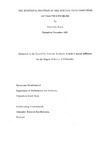The numerical solution of the dynamic fluid-structure interaction problem.
| dc.contributor.author | Harris, Paul John | |
| dc.contributor.other | School of Engineering, Computing and Mathematics | en_US |
| dc.date.accessioned | 2011-09-28T12:39:06Z | |
| dc.date.available | 2011-09-28T12:39:06Z | |
| dc.date.issued | 1989 | |
| dc.identifier | Not available | en_US |
| dc.identifier.uri | http://hdl.handle.net/10026.1/773 | |
| dc.description | Merged with duplicate record 10026.1/2055 on 12.04.2017 by CS (TIS) | |
| dc.description.abstract |
In this thesis we consider the problem of the dynamic fluid-structure interaction between a finite elastic structure and the acoustic field in an unbounded fluid-filled exterior domain. We formulate the exterior acoustic problem as an integral equation over the structure surface. However, the classical boundary integral equation formulations of this problem do not have unique solutions at certain characteristic frequencies (which depend on the surface) and it is necessary to employ modified boundary integral equation formulations which are valid for all frequencies. The modified integral equation formulation used here involves certain arbitrary parameters and we shall study the effect of these parameters on the stability and accuracy of the numerical methods used to solve the integral equation. We then couple the boundary element analysis of the exterior acoustic problem with a finite element analysis of the elastic structure to investigate the interaction between the structure and the acoustic field. Recently there has been some controversy over whether or not the coupled problem suffers from the non-uniqueness problems associated with the classical integral equation formulations of the exterior acoustic problem. We resolve this question by demonstrating that the solution to the coupled problem is not unique at the characteristic frequencies and that we need to employ an integral equation formulation valid for all frequencies. We discuss the accuracy of our numerical results for both the acoustic problem and the coupled problem, for a number of axisymmetric and fully three-dimensional problems. Finally, we apply our method to the problem of a piezoelectric sonar transducer transmitting an acoustic signal in water, and observe reasonable agreement between our theoretical predictions and some experimental results. | en_US |
| dc.description.sponsorship | Admiralty Research Establishment, Portland | |
| dc.language.iso | en | en_US |
| dc.publisher | University of Plymouth | en_US |
| dc.title | The numerical solution of the dynamic fluid-structure interaction problem. | en_US |
| dc.type | Thesis | |
| dc.identifier.doi | http://dx.doi.org/10.24382/3975 | |
| dc.identifier.doi | http://dx.doi.org/10.24382/3975 |
Files in this item
This item appears in the following Collection(s)
-
01 Research Theses Main Collection
Research Theses Main


